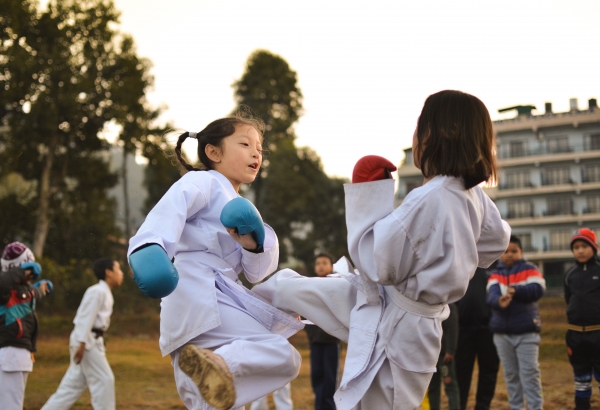Subscribe
Subscribe to our quarterly email newsletter 「ICM News」 to receive recent news about ICM, diverse writings by experts and youth, and relevant information.
Title [Martial Arts Globe] On Women and Girls in Combat Sports: Towards Inclusive Coaching

|
Photo by Jyotirmoy Gupta, no direct linkage with the below writing.
- Dr Alex Channon, University of Brighton
It is probably fair to say that in most countries around the world, combat sports have historically been practiced mostly by men and boys, and are generally considered ‘masculine’ activities. However, in recent years, various combat sports appear to have become increasingly popular among women and girls in a range of contexts. Specifically, there has been a significant growth of women’s competitive opportunities at the highest levels in sports such as boxing and mixed martial arts.
This raises some important questions: if combat sports have been historically male-dominated, how well-equipped are existing gyms to cater to women and girls? What difficulties might they face when entering these sports? And how do men – particularly male coaches – respond to their presence? These questions are regularly debated by academics, and have been a research interest of mine for several years.
In this short article, I offer a brief overview of some of the problems facing women in combat sports. I also make a few suggestions for things coaches can do to overcome them, before concluding with a list of suggested further readings on this topic.
Hitting and Hurting One of the most common problems that I found in my own research was that male training partners often did not want to hit, or otherwise ‘hurt’, the women they trained with. For this reason, they would very often avoid partnering with women to practice sparring, or if they could not, then they would work with them at very low intensities. Although most of the women I interviewed about this understood such men had good intentions, they experienced this as very frustrating, since it meant they were not able to spar properly or really learn how to cope with being hit – particularly if they were the only woman in their club, which was often the case.
To overcome this, coaches should give opportunities to women to demonstrate their skill and strength to the rest of the gym, and remind male training partners that they are not helping their female club-mates by going too easy on them in sparring.
‘It’s Only Banter’ Very often, in mostly-male spaces, the types of banter that are used to help social bonding can involve risqué jokes about women and sexuality. While some women may be happy with this, many are often not, and can interpret certain jokes or references to their gender – such as criticisms of ‘hitting like a girl’ – as being demeaning. This means that, rather than help members of a gym form social bonds with each other, such banter can in fact end up excluding people or encouraging them to leave.
Instead of making set rules about specific things people should not say in the gym – which can be experienced as a frustrating form of ‘political correctness’ – coaches should encourage gym members to be considerate of each other, and view everyone as important and valuable members of the social group. Hopefully, this will eliminate any demeaning ‘banter’.
Sex Objects A common problem reported on in some studies is for men in combat sports settings to view their female club-mates primarily as potential sexual partners. Although relationships within gyms are not necessarily a bad thing, most women do not want their male training partners to see them in a sexual way; they would rather be treated as equal members of the gym, who are there to train together and improve their abilities with each other’s help.
To facilitate this, male coaches should be careful to avoid talking about women in their clubs in a sexual way with other men who train there, and remind men who do this that they ought to show respect to their training partners as equals and peers – even if they might find them attractive. Women in Charge? Visible female role models and leaders can
have an important, inspirational impact on younger women entering mostly-male
spaces (and can also be a good thing for men).
In combat sports, where the majority of coaches and instructors are
male, opportunities to learn from women are rare. Typically, women who do coach are asked to
teach children’s classes, or work only with newcomers to gyms. This can send a negative message to women,
reinforcing the idea that only men can handle the responsibility of coaching
adults or leading a gym.
Although promoting a coach before she is ready is certainly not advisable, head coaches should be aware of the general tendency for women to be under-used as coaches, and also the value that seeing a female instructor or head coach can have in their gyms, and look out for opportunities to celebrate female leadership where appropriate.
Further Reading The following articles provide a more comprehensive account of these issues, and are freely available to access via the University of Brighton’s online repository. Links to further research can be found within these sources:
- Channon, A. (2014) Towards the ‘undoing’ of gender in mixed-sex martial arts and combat sports. Societies, 4(4), 587-605. - Channon, A. and Phipps, C. (2017) ‘Pink gloves still give black eyes’: Exploring ‘alternative’ femininity in women’s combat sports. Martial Arts Studies, 3, 24-37.
- Channon, A. (2018) Martial arts studies and the sociology of gender: Theory, research and pedagogical application. In P. Bowman (ed.) The Martial Arts Studies Reader. London: Rowman and Littlefield International, pp.155-170.
- Phipps, C., Khomutova, A. and Channon, A. (forthcoming) Coaching female combat athletes: Creating positive environments for women and girls. In J. Wallis and J. Lambert (eds.) Sport Coaching with Diverse Populations: Theory and Practice, Abingdon: Routledge.
※ This writing does not reflect the opinion of UNESCO ICM.
|
















